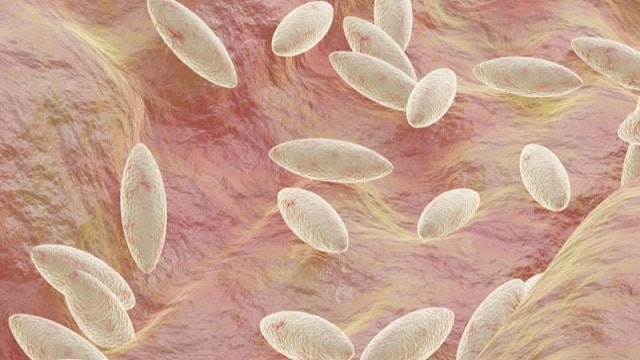Brucellosis
Brucellosis is a bacterial infection that spreads from animals to humans. It usually occurs when people consume raw or unpasteurized milk products. Sometimes, the bacteria that cause brucellosis can spread through the air or through direct contact with infected animals. Avoiding raw milk products and taking precautions when working with or interacting with livestock can help prevent brucellosis.
Symptoms of Brucellosis
Symptoms of brucellosis can appear anywhere from a few days to a few months after infection. Signs and symptoms are similar to the flu such as:
- Fever
- Hot and cold body
- Loss of appetite
- Sweating
- Weakness
- Fatigue
- Joint, muscle and back pain
- Headache
Symptoms of brucellosis may disappear for weeks or months and then return. Some people with chronic brucellosis may have symptoms for years, even after treatment.
The long-term signs and symptoms of brucellosis infection are:
- Fatigue
- Recurrent fever
- Inflammation of the inner lining of the heart chambers (endocarditis)
- Inflammation of the joints (arthritis)
- Arthritis of the spine (spondylitis)
- Arthritis of the joints where the spine and pelvis connect (sacroiliitis)
Causes of Brucellosis
There are several causes of brucellosis, including:
- Eat raw milk products
Brucella bacteria in the milk of infected animals can spread to humans in unpasteurized milk, ice cream, butter, and cheese. The bacteria can also be transmitted in raw or undercooked meat from infected animals.
- Breathing contaminated air
Brucella bacteria spread easily through the air. Farmers, hunters, lab technicians, and slaughterhouse workers can breathe the bacteria.
- Touching the blood and body fluids of infected animals
Bacteria in the blood, semen, or placenta of an infected animal can enter the bloodstream through a wound. People with weakened immune systems should avoid handling dogs known to have the disease.
Brucellosis is not usually spread from person to person, but in some cases, women have passed the disease to their children during childbirth or through breast milk. Brucellosis cannot be spread through sexual activity or through transfusions of contaminated blood or bone marrow.
Brucellosis Risk Factors
Brucellosis is very rare in the United States, and is more common in some countries, especially:
- Southern Europe, including Portugal, Spain, Türkiye, Italy, Greece, Southern France
- Eastern Europe
- Mexico, South and Central America
- Asia
- Africa
- Caribbean
- the Middle East
People who work with animals or who come into contact with infected blood are at higher risk of developing brucellosis. Examples include these professions:
- Veterinarian
- Dairy farmer
- Breeder
- Slaughterhouse worker
- Hunter
- Microbiologist
Diagnosis of Brucellosis
Typically, a doctor will confirm a diagnosis of brucellosis by testing the blood or bone marrow for the presence of brucella bacteria or by testing the blood for antibodies to the bacteria.
To help detect complications of brucellosis, your doctor will perform additional tests, including:
- X-ray
X-rays can reveal changes in the bones and joints.
- Computerized tomography (CT) scan or magnetic resonance imaging (MRI)
These imaging tests help identify inflammation or abscesses in the brain or other tissues.
- Cerebrospinal fluid culture
This is done to check a small sample of the fluid that surrounds the brain and spinal cord for infections such as meningitis and encephalitis.
- Echocardiography
This test uses sound waves to create images of the heart to check for signs of infection or damage to the heart.
Brucellosis Treatment
Treatment for brucellosis aims to relieve symptoms, prevent recurrence of the disease, and avoid complications. In addition, you must take antibiotics for at least six weeks, and symptoms may not disappear completely for several months. This is because the disease can also return and become chronic.
Brucellosis Complications
Brucellosis can affect almost any part of the body, including the reproductive system, liver, heart, and central nervous system. Chronic brucellosis can cause complications in just one organ or throughout the body. Possible complications include:
- Inflammation of the inner lining of the heart chambers (endocarditis)
This is one of the most serious complications of brucellosis. Untreated endocarditis can damage or destroy heart valves and is a leading cause of brucellosis-related death.
- Arthritis
In addition, arthritis is characterized by pain, stiffness, and swelling in the joints, especially the knees, hips, ankles, wrists, and spine. Inflammation of the joints in the spine (spondylitis) or the joints connecting the lower spine and pelvis (sacroiliitis), can be very difficult to treat and can cause permanent damage.
- Inflammation and infection of the testicles (Epididymitis)
The bacteria that cause brucellosis can infect the epididymis, a coiled tube that connects the vas deferens and the testicle. From there, the infection can spread to the testicle itself, causing swelling and pain that can be severe.
- Inflammation and infection of the spleen and liver
In fact, brucellosis can also affect the spleen and liver, causing them to enlarge beyond their normal size.
- Central nervous system infection
These include potentially life-threatening diseases such as inflammation of the membranes surrounding the brain and spinal cord (meningitis) or inflammation of the brain itself (encephalitis).
Brucellosis Prevention
So, to reduce the risk of getting brucellosis, take the following precautions:
- Avoid dairy foods that have not gone through the pasteurization process.
- Cook the meat until done.
- Wear gloves when interacting with wild animals.
- Pet vaccination.

